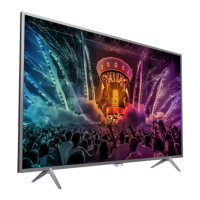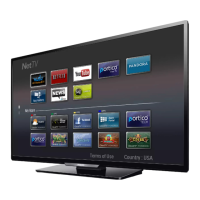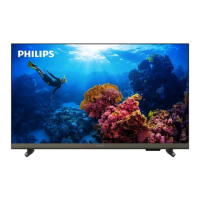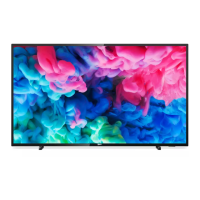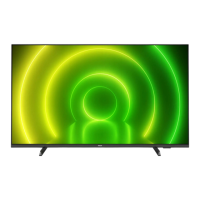Do you have a question about the Philips 49PUS6561 and is the answer not in the manual?
Introduces the integrated source menu for accessing channels and connected devices.
Explains how the TV recommends content like programs, videos, and online services.
Describes how to browse and mark media files like videos, songs, and photos as favorites.
Emphasizes reading safety instructions before operating the TV.
Provides instructions for mounting the TV stand or using a VESA-compliant wall mount.
Offers advice on optimal TV placement for viewing and Ambilight effect.
Details how to connect the power cable and safety precautions.
Explains how to connect an antenna for DVB-T and DVB-C signals.
Guides on connecting a satellite dish via an F-type connector.
Provides a detailed overview of all buttons on the top, middle, and bottom sections of the remote control.
Explains how to use voice search via an Android TV Remote Control app.
Describes the Qwerty/Azerty/Cyrillic keyboard layout on the remote and how to write text.
Details the function and placement of the infrared sensor for remote commands.
Instructions on how to replace the batteries in the remote control.
Guidance on how to clean the remote control safely.
Explains how to switch the TV on, put it in standby, or switch it off completely.
Describes how to perform basic TV operations using the TV's own keys if the remote is unavailable.
Guides through the process of installing satellite channels, including Unicable systems.
Covers manual installation, homing transponder, LNB, and problems with satellite reception.
Details how to copy and upload channel lists via USB for transferring settings.
Explains channel lists, filtering, and channel icons like star (new) and lock.
Provides a guide on connecting devices, emphasizing quality connections and cables.
Details HDMI quality, copy protection (HDCP), and the HDMI ARC feature for audio return.
Explains how to connect using YPbPr component video cables for HD signals.
Describes the SCART connection for CVBS and RGB signals, not for HD.
Explains the optical audio out connection for high-quality sound output to HTS.
Information on using a Conditional Access Module for premium TV channels.
Instructions on connecting a cable box or satellite receiver to the TV.
Guides on connecting Home Theatre Systems via HDMI ARC or optical audio.
How to connect smartphones and tablets wirelessly or via MHL.
Instructions for connecting a Blu-ray disc player using HDMI.
Details connecting a DVD player using HDMI or SCART.
Explains how to pair and connect Bluetooth devices like speakers and gamepads.
How to connect headphones and adjust their volume.
Guides on connecting game consoles via HDMI, YPbPr, or SCART, and setting the TV to Game mode.
Instructions for connecting gamepads via USB receiver or Bluetooth.
Details requirements and installation for using a USB Hard Drive for pausing or recording.
How to connect and configure a USB keyboard for text input.
Instructions for viewing media files from a USB flash drive.
How to connect a digital photo camera to view photos on the TV.
Guides on connecting a camcorder via HDMI or AV/SCART.
How to connect a computer and set the TV to ideal computer display settings.
Covers connecting the TV to a network wirelessly or via wired connection, including WPS setup.
Explains how to sign in with a Google Account for full Android TV capabilities.
Information on installing and using apps from the Philips App Gallery.
Details how to set and view Android-specific settings like language and location.
Describes the function and organization of the Home menu for accessing apps and settings.
Explains the role of apps for an enriched TV experience and where to find them.
Guides on using Google Play Movies & TV, Music, and Games for content and entertainment.
Instructions on how to start, stop, or exit an application on the TV.
Details how to lock apps by age rating or set up a restricted profile for child safety.
How to stop, clear cache, uninstall, or move apps for performance optimization.
Information on checking TV storage usage and using a USB Hard Drive for extended storage.
How to start the TV's internet browser to access websites.
Explains various options available within the internet browser, like entering addresses or managing favorites.
Describes the TV Menu as an alternative to the Home menu when the internet is unavailable.
Instructions on how to open and navigate items within the TV Menu.
How to switch between different connected devices and tuners via the Sources menu.
Setting options for specific TV inputs, including operating connected devices.
How to rename or change the type of a connected device for automatic settings.
Connecting a computer and setting the TV for optimal computer display.
Adjusting picture settings, styles, colour, and contrast for optimal viewing.
Adjusting sound styles, bass, treble, headphone volume, and surround modes.
Configuring Ambilight styles, brightness, saturation, and advanced settings.
Managing energy-saving features like Energy Saving, Screen Off, and Light Sensor.
Settings for USB Hard Drive, USB Keyboard, Philips Logo brightness, and Home/Shop location.
Changing TV menus, audio languages, and subtitle preferences.
Features for users with hearing or visual impairments, including audio description and mixed volume.
Setting parental ratings and app locks using a PIN code for child safety.
Viewing media files directly from a connected USB flash drive or USB Hard Drive.
Accessing media files stored on a computer or Network Attached Storage.
Viewing media from cloud storage services via the Cloud Explorer app.
Browsing media files categorized as favourites, most popular, or last played.
Controls for playing videos, including playback, subtitles, and audio language selection.
Features for viewing photos, such as slideshows, rotation, and shuffle playback.
Controls for playing music files, including playback, shuffle, and repeat options.
Explains the TV Guide's function and what information it provides about TV programs.
How the TV obtains TV Guide information from broadcasters or the internet.
Instructions on opening, tuning to programs, viewing details, and setting reminders.
Guides on recording digital TV broadcasts, scheduling recordings, and handling conflicts.
Explains how to pause and resume live TV broadcasts and replay recent content.
Details the Philips TV Remote App for controlling the TV and accessing content.
How to cast content from mobile devices to the TV using Google Cast.
Mentions adding AirPlay functionality via Android apps.
Connecting mobile devices via MHL for screen sharing and charging.
Requirements for playing games from the App Gallery, Google Play Store, or game consoles.
Instructions on how to start and play games from the Home menu or a connected game console.
Options for setting Ambilight to follow video, audio, or preset color styles.
How to switch off the Ambilight feature.
Detailed settings and configurations for Ambilight features.
Explains what Top Picks recommends, including programs, videos, and online services.
How to use the "Now on TV" feature for popular current programs.
Accessing missed or favorite TV programs through the TV on Demand service.
Renting movies from online video stores via the Video on Demand service.
Watching a TV channel in a small screen while viewing Text content.
Watching a TV channel alongside video from a connected HDMI device.
Watching a TV channel while using a Nettv app.
Watching a Nettv app alongside video from an HDMI device.
Instructions for updating the TV software from the internet or a USB flash drive.
How to view the current TV software version and release notes.
Information on obtaining the source code for open source software used in the TV.
Details regarding open source licenses for software components like Android and Linux kernel.
How to receive and read announcements on new TV software or related issues.
Information on the European Energy Label, product fiche, and end-of-life disposal.
Details on power specifications, mains voltage, and operating conditions.
Information about the TV's operating system, Android Marshmallow 6.0.
Technical details on aerial, tuner bands, DVB standards, and satellite input.
Repeats reception details for aerial, tuner bands, and DVB standards.
Specifications for screen sizes and display resolution.
Supported video and computer input resolutions and refresh rates.
Lists all available TV ports and connections, including HDMI, USB, and CI+.
Details on sound features like wOOx, HD Stereo, and Dolby Digital Plus.
Supported multimedia connections, file formats, codecs, and limitations.
Benefits and process for registering the TV for support and product updates.
How to access the on-screen user manual and download TV help for other devices.
Solutions for common TV problems like not switching on, remote control issues, and channel problems.
How to access online support, FAQs, and download manuals from the Philips website.
Contact information for customer care, and warnings against self-repair.
Important safety instructions regarding electric shock, fire, injury, and overheating risks.
Guidelines for safely cleaning the TV screen and avoiding screen damage from static images.
Legal terms and conditions for using the TV, including warranty and compliance information.
Information regarding terms of use for apps within the Philips App Gallery.
Trademark information for MHL technology.
Trademark information for the DIGITALEUROPE UHD Display Logo.
Trademark information for HDMI and its logo.
Licensing and trademark information for Dolby Digital Plus.
Patent and trademark information for DTS Premium Sound.
Trademark and content protection information for Microsoft technologies.
Trademark information for Wi-Fi Alliance and its logos.
Trademark information for Kensington security products.
General statement about other registered and unregistered trademarks.
Introduces the integrated source menu for accessing channels and connected devices.
Explains how the TV recommends content like programs, videos, and online services.
Describes how to browse and mark media files like videos, songs, and photos as favorites.
Emphasizes reading safety instructions before operating the TV.
Provides instructions for mounting the TV stand or using a VESA-compliant wall mount.
Offers advice on optimal TV placement for viewing and Ambilight effect.
Details how to connect the power cable and safety precautions.
Explains how to connect an antenna for DVB-T and DVB-C signals.
Guides on connecting a satellite dish via an F-type connector.
Provides a detailed overview of all buttons on the top, middle, and bottom sections of the remote control.
Explains how to use voice search via an Android TV Remote Control app.
Describes the Qwerty/Azerty/Cyrillic keyboard layout on the remote and how to write text.
Details the function and placement of the infrared sensor for remote commands.
Instructions on how to replace the batteries in the remote control.
Guidance on how to clean the remote control safely.
Explains how to switch the TV on, put it in standby, or switch it off completely.
Describes how to perform basic TV operations using the TV's own keys if the remote is unavailable.
Guides through the process of installing satellite channels, including Unicable systems.
Covers manual installation, homing transponder, LNB, and problems with satellite reception.
Details how to copy and upload channel lists via USB for transferring settings.
Explains channel lists, filtering, and channel icons like star (new) and lock.
Provides a guide on connecting devices, emphasizing quality connections and cables.
Details HDMI quality, copy protection (HDCP), and the HDMI ARC feature for audio return.
Explains how to connect using YPbPr component video cables for HD signals.
Describes the SCART connection for CVBS and RGB signals, not for HD.
Explains the optical audio out connection for high-quality sound output to HTS.
Information on using a Conditional Access Module for premium TV channels.
Instructions on connecting a cable box or satellite receiver to the TV.
Guides on connecting Home Theatre Systems via HDMI ARC or optical audio.
How to connect smartphones and tablets wirelessly or via MHL.
Instructions for connecting a Blu-ray disc player using HDMI.
Details connecting a DVD player using HDMI or SCART.
Explains how to pair and connect Bluetooth devices like speakers and gamepads.
How to connect headphones and adjust their volume.
Guides on connecting game consoles via HDMI, YPbPr, or SCART, and setting the TV to Game mode.
Instructions for connecting gamepads via USB receiver or Bluetooth.
Details requirements and installation for using a USB Hard Drive for pausing or recording.
How to connect and configure a USB keyboard for text input.
Instructions for viewing media files from a USB flash drive.
How to connect a digital photo camera to view photos on the TV.
Guides on connecting a camcorder via HDMI or AV/SCART.
How to connect a computer and set the TV to ideal computer display settings.
Covers connecting the TV to a network wirelessly or via wired connection, including WPS setup.
Explains how to sign in with a Google Account for full Android TV capabilities.
Information on installing and using apps from the Philips App Gallery.
Details how to set and view Android-specific settings like language and location.
Describes the function and organization of the Home menu for accessing apps and settings.
Explains the role of apps for an enriched TV experience and where to find them.
Guides on using Google Play Movies & TV, Music, and Games for content and entertainment.
Instructions on how to start, stop, or exit an application on the TV.
Details how to lock apps by age rating or set up a restricted profile for child safety.
How to stop, clear cache, uninstall, or move apps for performance optimization.
Information on checking TV storage usage and using a USB Hard Drive for extended storage.
How to start the TV's internet browser to access websites.
Explains various options available within the internet browser, like entering addresses or managing favorites.
Describes the TV Menu as an alternative to the Home menu when the internet is unavailable.
Instructions on how to open and navigate items within the TV Menu.
How to switch between different connected devices and tuners via the Sources menu.
Setting options for specific TV inputs, including operating connected devices.
How to rename or change the type of a connected device for automatic settings.
Connecting a computer and setting the TV for optimal computer display.
Adjusting picture settings, styles, colour, and contrast for optimal viewing.
Adjusting sound styles, bass, treble, headphone volume, and surround modes.
Configuring Ambilight styles, brightness, saturation, and advanced settings.
Managing energy-saving features like Energy Saving, Screen Off, and Light Sensor.
Settings for USB Hard Drive, USB Keyboard, Philips Logo brightness, and Home/Shop location.
Changing TV menus, audio languages, and subtitle preferences.
Features for users with hearing or visual impairments, including audio description and mixed volume.
Setting parental ratings and app locks using a PIN code for child safety.
Viewing media files directly from a connected USB flash drive or USB Hard Drive.
Accessing media files stored on a computer or Network Attached Storage.
Viewing media from cloud storage services via the Cloud Explorer app.
Browsing media files categorized as favourites, most popular, or last played.
Controls for playing videos, including playback, subtitles, and audio language selection.
Features for viewing photos, such as slideshows, rotation, and shuffle playback.
Controls for playing music files, including playback, shuffle, and repeat options.
Explains the TV Guide's function and what information it provides about TV programs.
How the TV obtains TV Guide information from broadcasters or the internet.
Instructions on opening, tuning to programs, viewing details, and setting reminders.
Guides on recording digital TV broadcasts, scheduling recordings, and handling conflicts.
Explains how to pause and resume live TV broadcasts and replay recent content.
Details the Philips TV Remote App for controlling the TV and accessing content.
How to cast content from mobile devices to the TV using Google Cast.
Mentions adding AirPlay functionality via Android apps.
Connecting mobile devices via MHL for screen sharing and charging.
Requirements for playing games from the App Gallery, Google Play Store, or game consoles.
Instructions on how to start and play games from the Home menu or a connected game console.
Options for setting Ambilight to follow video, audio, or preset color styles.
How to switch off the Ambilight feature.
Detailed settings and configurations for Ambilight features.
Explains what Top Picks recommends, including programs, videos, and online services.
How to use the "Now on TV" feature for popular current programs.
Accessing missed or favorite TV programs through the TV on Demand service.
Renting movies from online video stores via the Video on Demand service.
Watching a TV channel in a small screen while viewing Text content.
Watching a TV channel alongside video from a connected HDMI device.
Watching a TV channel while using a Nettv app.
Watching a Nettv app alongside video from an HDMI device.
Instructions for updating the TV software from the internet or a USB flash drive.
How to view the current TV software version and release notes.
Information on obtaining the source code for open source software used in the TV.
Details regarding open source licenses for software components like Android and Linux kernel.
How to receive and read announcements on new TV software or related issues.
Information on the European Energy Label, product fiche, and end-of-life disposal.
Details on power specifications, mains voltage, and operating conditions.
Information about the TV's operating system, Android Marshmallow 6.0.
Technical details on aerial, tuner bands, DVB standards, and satellite input.
Repeats reception details for aerial, tuner bands, and DVB standards.
Specifications for screen sizes and display resolution.
Supported video and computer input resolutions and refresh rates.
Lists all available TV ports and connections, including HDMI, USB, and CI+.
Details on sound features like wOOx, HD Stereo, and Dolby Digital Plus.
Supported multimedia connections, file formats, codecs, and limitations.
Benefits and process for registering the TV for support and product updates.
How to access the on-screen user manual and download TV help for other devices.
Solutions for common TV problems like not switching on, remote control issues, and channel problems.
How to access online support, FAQs, and download manuals from the Philips website.
Contact information for customer care, and warnings against self-repair.
Important safety instructions regarding electric shock, fire, injury, and overheating risks.
Guidelines for safely cleaning the TV screen and avoiding screen damage from static images.
Legal terms and conditions for using the TV, including warranty and compliance information.
Information regarding terms of use for apps within the Philips App Gallery.
Trademark information for MHL technology.
Trademark information for the DIGITALEUROPE UHD Display Logo.
Trademark information for HDMI and its logo.
Licensing and trademark information for Dolby Digital Plus.
Patent and trademark information for DTS Premium Sound.
Trademark and content protection information for Microsoft technologies.
Trademark information for Wi-Fi Alliance and its logos.
Trademark information for Kensington security products.
General statement about other registered and unregistered trademarks.
| Screen Size | 49 inches |
|---|---|
| Display Technology | LED |
| Smart TV | Yes |
| Operating System | Android TV |
| HDMI Ports | 4 |
| USB Ports | 3 |
| Audio Output | 20 W |
| Ambilight | Yes |
| Component video (YPbPr/YCbCr) in | Yes |
| Ethernet LAN | Yes |
| Wi-Fi | Yes |
| Processor | Quad-core |
| Bluetooth | Yes |
| Resolution | 3840 x 2160 pixels |
| Digital signal format system | DVB-T2, DVB-C, DVB-S2 |
| HDR Support | Yes (HDR10, HLG) |





